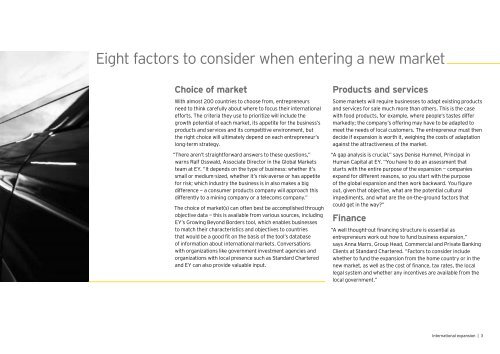International expansion
TI4ND
TI4ND
Create successful ePaper yourself
Turn your PDF publications into a flip-book with our unique Google optimized e-Paper software.
Eight factors to consider when entering a new market<br />
Choice of market<br />
With almost 200 countries to choose from, entrepreneurs<br />
need to think carefully about where to focus their international<br />
efforts. The criteria they use to prioritize will include the<br />
growth potential of each market, its appetite for the business’s<br />
products and services and its competitive environment, but<br />
the right choice will ultimately depend on each entrepreneur’s<br />
long-term strategy.<br />
“There aren’t straightforward answers to these questions,”<br />
warns Ralf Osswald, Associate Director in the Global Markets<br />
team at EY. “It depends on the type of business: whether it’s<br />
small or medium-sized, whether it’s risk-averse or has appetite<br />
for risk; which industry the business is in also makes a big<br />
difference — a consumer products company will approach this<br />
differently to a mining company or a telecoms company.”<br />
The choice of market(s) can often best be accomplished through<br />
objective data — this is available from various sources, including<br />
EY’s Growing Beyond Borders tool, which enables businesses<br />
to match their characteristics and objectives to countries<br />
that would be a good fit on the basis of the tool’s database<br />
of information about international markets. Conversations<br />
with organizations like government investment agencies and<br />
organizations with local presence such as Standard Chartered<br />
and EY can also provide valuable input.<br />
Products and services<br />
Some markets will require businesses to adapt existing products<br />
and services for sale much more than others. This is the case<br />
with food products, for example, where people’s tastes differ<br />
markedly; the company’s offering may have to be adapted to<br />
meet the needs of local customers. The entrepreneur must then<br />
decide if <strong>expansion</strong> is worth it, weighing the costs of adaptation<br />
against the attractiveness of the market.<br />
“A gap analysis is crucial,” says Denise Hummel, Principal in<br />
Human Capital at EY. “You have to do an assessment that<br />
starts with the entire purpose of the <strong>expansion</strong> — companies<br />
expand for different reasons, so you start with the purpose<br />
of the global <strong>expansion</strong> and then work backward. You figure<br />
out, given that objective, what are the potential cultural<br />
impediments, and what are the on-the-ground factors that<br />
could get in the way?”<br />
Finance<br />
“A well thought-out financing structure is essential as<br />
entrepreneurs work out how to fund business <strong>expansion</strong>,”<br />
says Anna Marrs, Group Head, Commercial and Private Banking<br />
Clients at Standard Chartered. “Factors to consider include<br />
whether to fund the <strong>expansion</strong> from the home country or in the<br />
new market, as well as the cost of finance, tax rates, the local<br />
legal system and whether any incentives are available from the<br />
local government.”<br />
<strong>International</strong> <strong>expansion</strong> | 3









